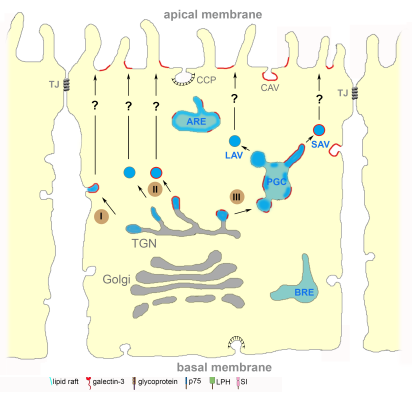Main Content
Apical protein transport
Membranes of epithelial cells are separated by tight junctions into an apical domain facing the organ lumen and a basolateral domain adjacent to neighboring cells or the basal membrane. Both membrane domains differ substantially in their protein and lipid composition. Proteins associated with sphingolipid- and cholesterol-enriched membrane microdomains, the so-called lipid rafts, are predominantly transported to the apical membrane by using rafts as transport platform (sucrase-associated vesicle, SAV). On the other hand, alternative pathways exist for the delivery of non-raft associated cargo molecules to the apical membrane (lactase-associated vesicle, LAV). Raft- and non-raft apical pathways are separated after exit of newly synthesized cargo from the Golgi apparatus. In contrast to the classical view of a direct passage from the Golgi to the apical membrane, our data suggest that endosomes are traversed following Golgi-release and serve as additional sorting organelle for polarized trafficking. Transport machinery of this pathway was analyzed on immunoisolated post-Golgi carriers and comprises specific Rab-GTPases, kinesin motor proteins and adapter molecules for transport like Mx1 or annexins.
Current projects in the group deal with further illumination distinct compartments traversed after Golgi-exit and the cellular machinery involved.
